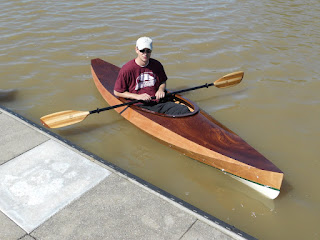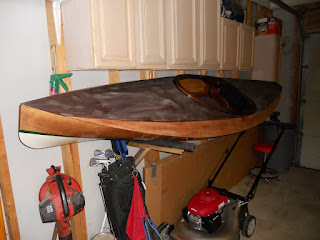The humidity has been too high to finish the varnish on the days I have been able to work on the kayak this week. So tonight I installed the seat and backrest, pretty easy, took less than an hour. The seat and backrest are included in the kit and nicer ones are available also. Im curious how comfortable this simple seat will be.

In the picture above you can see that the seat is built from two layers of foam which you need to glue together with contact cement. Mine had a chunk missing from the bottom piece. The missing chunk broke off along the outside edge and is nowhere to be found in the packaging. My only complaint about the entire kit has been the packing. I was shorted fiberglass tape, you might remember and now the seat is missing a chunk of foam, not a big deal as its hidden from view and I am sure they would send another if I emailed CLC about it but there seems to be room for improvement in the packaging quality control. Anyway...

The seatback gets straped in place and held with two screws under the aft cockpit coaming. Then two nylon straps exted forward and also screw under the coaming to support the seatback as you lean against the backrest. The seat bottom just gets contact cemented in place but I decided to just velcro it in place for now in case I want to adjust its position.
The last thing I did tonight was finish up the rack for storing my kayak. I bought a kayak wall rack from Dicks Sporting Goods but it wouldnt fit the WoodDuck. So I just made a simple rack with some 1x3 lumber screwed to my garage wall studs. I added a little pipe insulation to the edge of the 1x3 to protect the bottom paint.
Tomorrow is the only day without rain in the forecast so I hope to finish varnishing the deck.




 Finished the 3rd coat of varnish on the deck today. I added a little too much thinner so it was easy to leave a couple "holidays". As much as I enjoy it my brain cells need some time to detox from huffing fumes everyday. I'll launch the kayak as is, and when we get a perfect day for varnishing, I will do another coat on the deck to try and eliminate the thin spots. Im really, really pleased with the smooth, glassy finish the Epifanes varnish provides.
Finished the 3rd coat of varnish on the deck today. I added a little too much thinner so it was easy to leave a couple "holidays". As much as I enjoy it my brain cells need some time to detox from huffing fumes everyday. I'll launch the kayak as is, and when we get a perfect day for varnishing, I will do another coat on the deck to try and eliminate the thin spots. Im really, really pleased with the smooth, glassy finish the Epifanes varnish provides.
 In the picture above you can see that the seat is built from two layers of foam which you need to glue together with contact cement. Mine had a chunk missing from the bottom piece. The missing chunk broke off along the outside edge and is nowhere to be found in the packaging. My only complaint about the entire kit has been the packing. I was shorted fiberglass tape, you might remember and now the seat is missing a chunk of foam, not a big deal as its hidden from view and I am sure they would send another if I emailed CLC about it but there seems to be room for improvement in the packaging quality control. Anyway...
In the picture above you can see that the seat is built from two layers of foam which you need to glue together with contact cement. Mine had a chunk missing from the bottom piece. The missing chunk broke off along the outside edge and is nowhere to be found in the packaging. My only complaint about the entire kit has been the packing. I was shorted fiberglass tape, you might remember and now the seat is missing a chunk of foam, not a big deal as its hidden from view and I am sure they would send another if I emailed CLC about it but there seems to be room for improvement in the packaging quality control. Anyway... 







 I also brought my other boat I built out of storage today and brought it home.
I also brought my other boat I built out of storage today and brought it home.